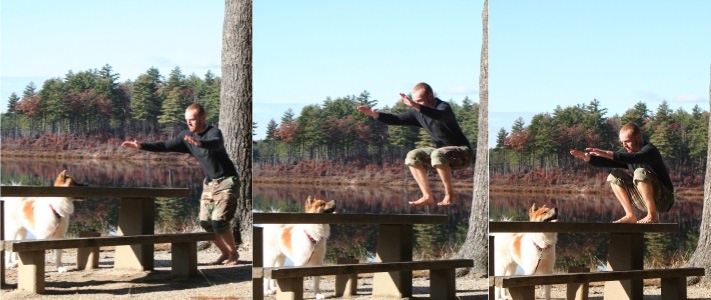
Jumping is a movement skill that is often overlooked in traditional fitness programs. I actually just recently started including more jumping in my own training program – not just for skill improvement, but also for conditioning purposes. My jumping experience had been mostly confined to doing box jumps at the local gym, but it wasn’t until I attended a MovNat natural movement training seminar that I realized the value of learning how to jump efficiently.
Below, you’ll find some pictures of me practicing vertical jumping onto a picnic table at my local park. I’ll detail some of the key points for making a successful jump. This is only one kind of jumping technique – there are many. You’ll see a few more ideas for training in the video below, but this is also only a sampling. When you learn how to jump properly, it opens up a whole new perspective for different training possibilities. How high are you jumping? How far? On what surface? What do you need to do after the jump? These things and many others come into context when applying jump training to your program.
Anatomy of a Jump
Phase 1 – adopt a mid-foot balance, lean forward, lengthen spine, begin to swing arms backwards
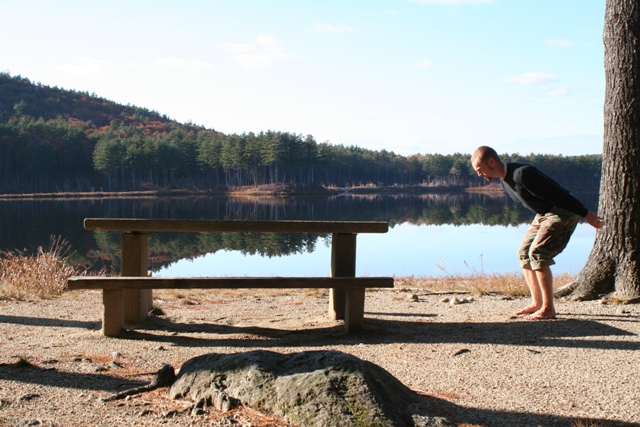
Phase 2 – continue the forward bend, storing elastic tension in your posterior chain, coiling your body down into the earth like a spring ready to jump
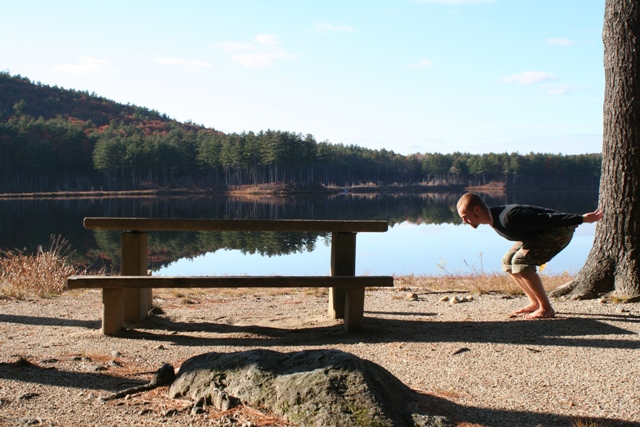
Phase 3 – begin leg drive, pressing feet into the earth as arms start to swing forward
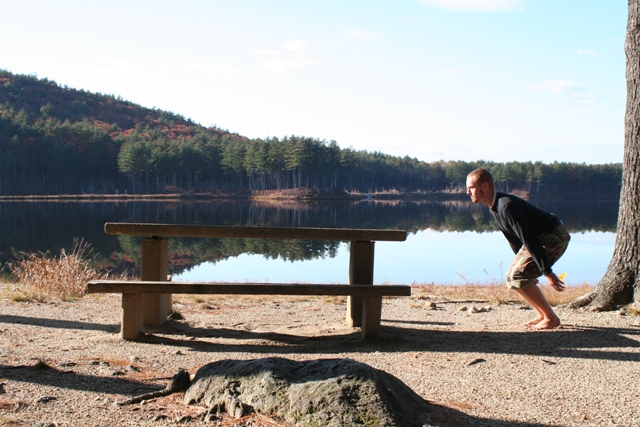
Phase 4 – extend hips forcefully, allowing knees and ankles to fully extend for extra power generation
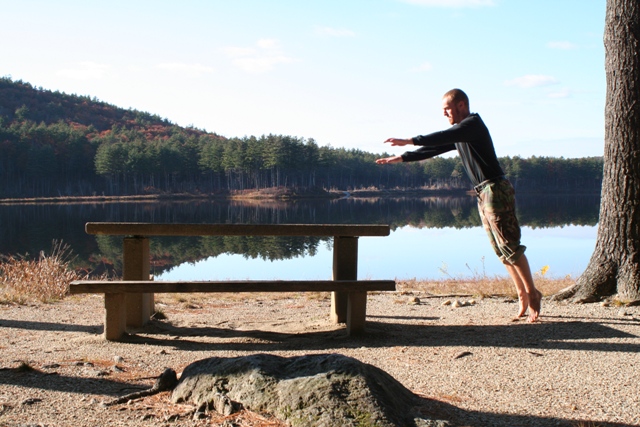
Phase 5 – consciously pull yourself to your target through the air. Even after the force generation is complete, you need to actively control your movement. It’s true that you are weightless for a moment, but that doesn’t mean you should give up conscious control.
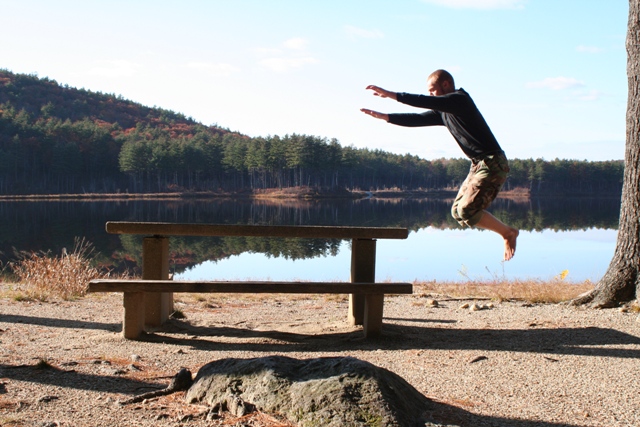
Phase 6 – reach for your target with your feet, and ensure good posture for landing
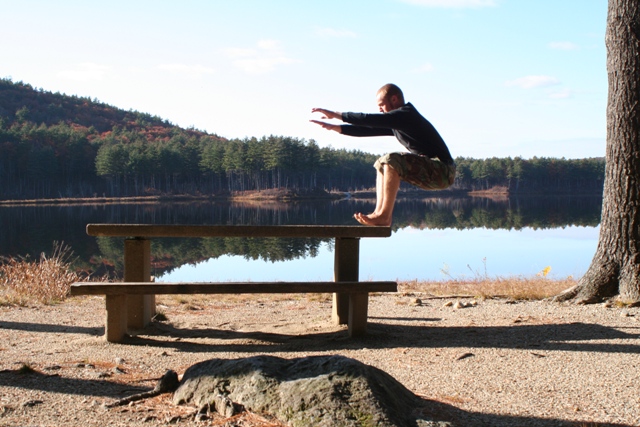
Phase 7 – absorb bodyweight onto a flat foot, mid-foot balance with a tall posture (squat, partial squat, or standing depending on the height of the jump). The landing should be soft, even quiet, as you distribute the force of impact throughout your entire body structure.
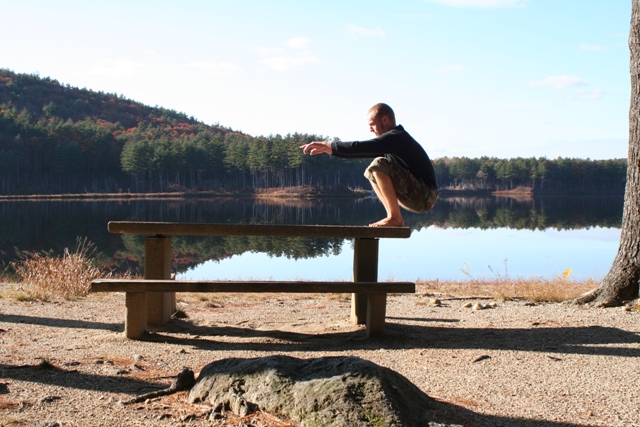
It seems complicated, and it is when you think about it (and overthink about it). But with good coaching and ample practice, this movement becomes almost automatic where you don’t have to think about the key points anymore. Instead, you just think, I’m going to jump there.
Here are some more examples of different jumping drills you can do with a picnic table, or anything at an elevated height:
Do keep in mind that even though jumping is a natural human movement, proper jumping technique does not come naturally to human’s. This post was meant to give you a better understanding of a proper jump, but NOT to replace good coaching. You won’t learn how to jump efficiently or effectively from an online tutorial. You need in-person coaching with someone who is qualified to teach. I recommend seeking out a MovNat coach for professional instruction.
To your health and success,
.jpg)
![]()
CST, CST-KS, NSCA-CPT
Fitness Professional and MovNat training alumni

John,
great work man! we have been employing lots of this proper jumping and creating new challenges in our Mocean365 work. picnic tables and playgrounds are perfect for new challenges. adding matrix’s eventually as well.
love the new site. looks way cleaner and refined for sure. keep up the great work and if your ever in Northern Vt, give a holler and maybe we can jump around bro!
peace
Hi Skye,
Thanks for the shout. There is so much that can be done at the local playground and even just with a picnic table – keep it real bro!
Best,
John
Jumping (more significantly the landing) is one of the skills that a lot or people and i mean A LOT of people can’t do properly. Even though they may be doing sports that require jumping. No wonder there are so many injuries.
It’s so true, Herman. Even with coaching, it’s not a skill that is easily mastered, which I’ve witnessed many times. It’s true that jumping is a natural human movement, but that doesn’t mean “efficiently effective” jumping comes naturally. It’s a skill like anything else, and it requires practice.
There are a lot of people who would argue that as long as you can effectively make a jump (successful traveling to target destination), you are a good jumper. I don’t think it’s that simple. If you cannot jump and land with proper structural alignment, proper breathing (for you CST’s: discipline level or flow level breathing, not power or fear level breathing), and proper movement (ie smooth absorption of bodyweight, not hard impact), then you are not making a good jump.
Of course, every situation warrants different action, and the context defines how you proceed. If you are jumping to save your life, it isn’t as important to have perfect technique. In training though, where one of the goals is not only improved performance but health and longevity, making perfect jumps is of paramount importance. I’ve heard too many parkour guys give terrible advice to “just jump” and people start getting injured and wonder why.